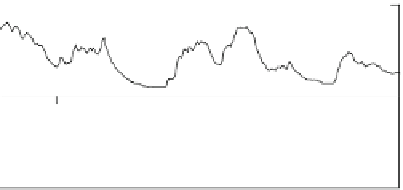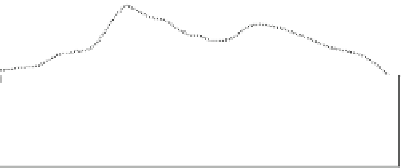Environmental Engineering Reference
In-Depth Information
Fig. 11.1 Over-speeding of
the Aerogenesis 5 kW wind
turbine
20
U (m/s)
10
0
100
25
30
35
40
45
50
Ω
(rad/s)
50
100
0
25
30
35
40
45
50
Tip speed ratio,
λ
50
0
0
5
10
15
20
25
30
35
Time (s)
generators require a field current to provide the magnetic field, they have more
losses than well designed PMGs, and are generally less efficient.
Figure
11.2
shows the very simple structure of a PMG, in this case the Ginlong
500-A that was used with the blade design example in
Chap. 7
. The modeling of
PMGs is well understood, e.g. Gieras and Wing [
1
] and Proca et al. [
2
]. The blade
holder is normally bolted directly to the input shaft in Fig.
11.1
. In addition to
being simple, PMGs with many poles—there are 16 poles on the PMG in
Fig.
11.2
—perform efficiently at low rpm which usually means they do not need a
gearbox. The permanent magnets are attached to the rotor which rotates inside the
stator carrying the windings. It can be appreciated that detachment of the magnets
could cause major problems and be hard to repair. At least some rare earth magnets
(e.g. NeFeB) can burn if the protective coating is worn off by striking part of the
stator. Some PMG rotors have a lining of fibreglass or iron to keep the magnets in
place. All PMGs should have a maximum speed rating below which it is guar-
anteed to keep the magnets in place for the lifetime of the generator.
Table
11.1
lists the main generator parameters provided by the manufacturer or
measured by the methods documented in Kondo [
3
], and indicates their use in
turbine design, modeling, and/or converter design. The manufacturer's specifica-
tions for rated power and rpm are lower than those used in
Chap. 7
implying that
the onus is on the designer to justify the increase in rated conditions.
The maximum efficiency of the generator normally occurs at its highest voltage
(which means rated speed, or higher), because for the same power output,
the generator current is less. Conduction or ''copper'' losses increase with an
increase in the generator current as the wires get hotter. There are losses from the
generator iron being magnetised and demagnetised many times per rotation (called
iron losses). These losses depend on the magnetic field strength and the generator
speed.
A PMG operated at a constant rpm produces maximum power when the load
impedance matches that of the generator. This can be achieved by adding
capacitance, but the amount needed is dependent on generator speed (i.e. fre-
quency) and maximum power transfer comes at the price of a dramatic loss














































































Search WWH ::

Custom Search